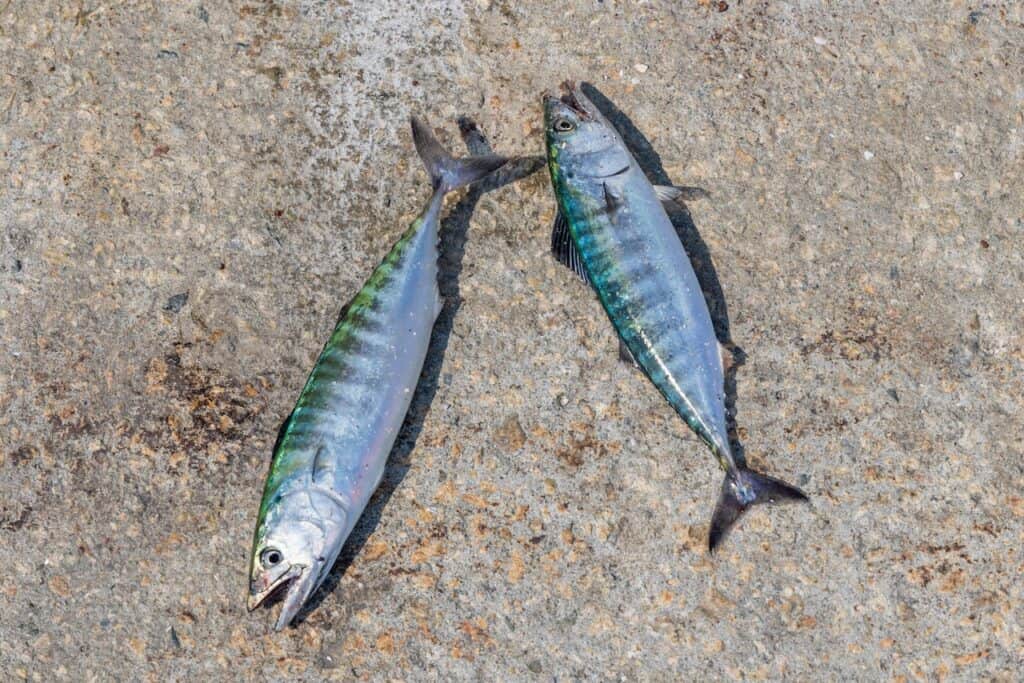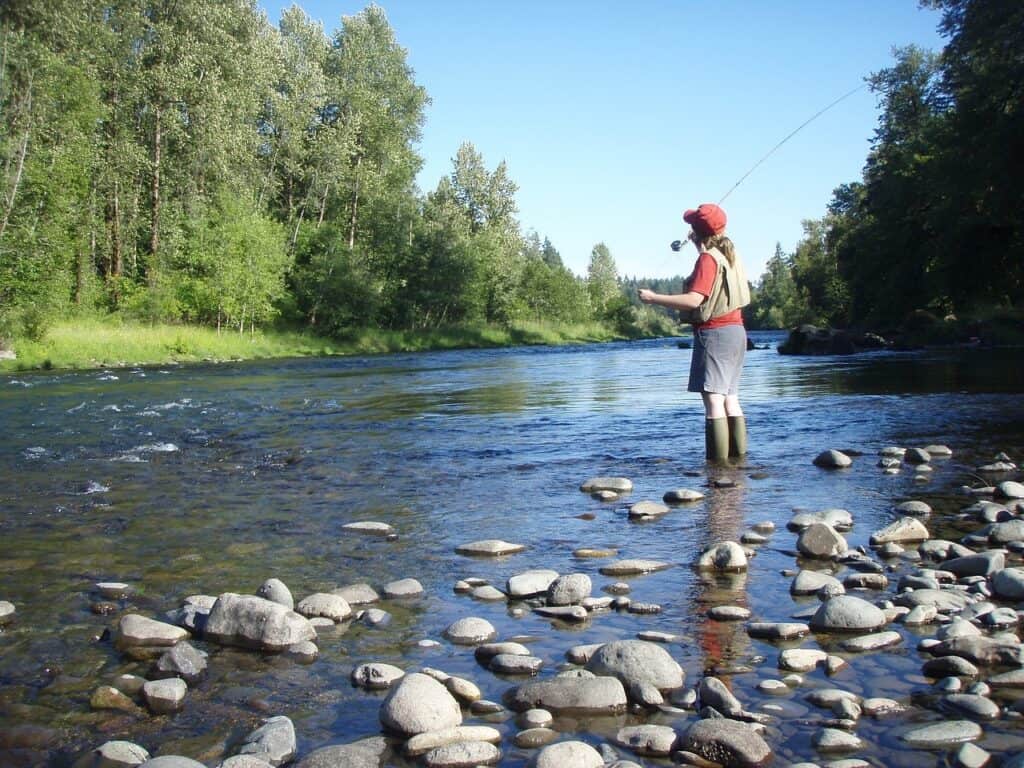
Fly fishing isn’t about the fish. Instead, it is about the fly fisherman’s journey to the fish. People pick up a fly rod to challenge themselves and enjoy the soul-strumming poetry of the process.
Of all the fish fly fishermen pursue, the Atlantic bonito is one of the most challenging. The average fisherman catches the silvery fish with deep-diving crankbaits and an outboard motor. But hours of trolling may result in only a few hookups and even fewer bonitos in the freezer.
Catching them from the surf adds a layer of difficulty most fishermen don’t even attempt. Even fewer, yet more intrepid fishermen, pursue them with a fly rod. When successful, these adventurers achieve much more than endless bragging rights. For the rest of their lives, they know they have what it takes to conquer anything the salty sapphire depths throw at them.
Keep reading to find out more about Atlantic bonito on a fly.
All About Atlantic Bonito
Atlantic bonito are typically overlooked as they resemble other members of the mackerel family but are inferior in size. The average bonito will only grow to about twelve pounds, but the rare bonito will grow larger; one caught in the Azores Islands weighed eighteen pounds!
As a member of the mackerel family, the Atlantic bonito shares many of the same physical features as the Spanish or King Mackerel. They sport a wavy lateral line that proceeds from their gill plate and is crossed by several horizontal stripes. With its pointed snout, pronounced dorsal fin, and torpedo-like body, the Atlantic bonito is a beautiful fish to behold.
However, their inferior size has resulted in an unwarranted lack of interest in pursuing the bonito by commercial fishermen, but this has not prevented them from being caught in mass. Since they typically feed on the same squid and baitfish as tuna, they are often bycaught in commercial fishing nets.
Though commercial fisherman views bonito as a nuisance, fly fishermen see them as trophy. Bonito are fast and furious in everything they do. They waste no time in schooling and feeding as soon as they hatch. This leads them to a rapid growth cycle of two to three years. As they mature, their growing levels off, but that does not stop them from feeding at the same pace.
Where to Find Atlantic Bonito
Typically, Atlantic bonito are suspended in medium depths, avoiding the bottom and only breaching the surface in pursuit of prey. For most of the year, they traverse the ocean, following squid and other important bait species across the oceans.
However, everything changes when the water temperatures rise and the Atlantic bonito seeks to spawn. They begin to desire shallower, calmer waters that provide them with a good mix of security and food to broadcast their eggs and sperm.
This provides the fly fisherman with a unique opportunity. Though they can be caught at any time of the year, from May to July the Atlantic bonito will undoubtedly be in wadable depths that put them within reach of fly fishermen.
Picking the Right Water

When fly fishing for Atlantic bonito, it is essential to remember they are fast-moving fish that have migrated to shallower depths to spawn and feed. Seek out inlets that provide calm, such as shallow flats with access to deep-flowing water. Runoffs and river inlets are great places to find schools of bonito chasing baitfish and squid.
Always pay close attention to the impact the surface structure has on the waters the bonito may inhabit. Jettys, docks, or other structures shield the bonito from the current while providing cover for smaller baitfish to escape predators. Many world-class Atlantic bonito have been caught cruising the sides of these structures, searching for their next meal.
Packing the Tacklebox
Atlantic bonito doesn’t require anything out of the ordinary to be caught. Though they can be challenging to locate, they are still excellent beginner fish that you can land without overly aggressive hooksets and complicated tackle.
Rods—For Atlantic bonito, a nine-weight rod will provide you with the strength needed to land the strong fish but without the cost of shoulder pain from casting a higher-weight rod.
Reels— While most inshore fly fishing doesn’t require a strong reel, catching Atlantic bonito on a fly does. A smooth drag with at least two hundred yards of backing is essential to successfully landing these fish.
Leaders—Choosing the appropriate leader for Atlantic bonito is difficult due to the various conditions and situations they can be found in. There is a strong argument that the fish are leader shy, but they also have a reputation for breaking lines. Eight-foot leaders with a fifteen-pound test tippet should be the starting point for a day of fishing, but you should have heavier lines and tippet if needed.
Flies— Flies should always be baitfish imitators. White bunny flies, epoxy flies, spoon flies, and Clouser minnows are all excellent choices. However, knowledge of your local waters, what the bonito are currently feeding on, water clarity, and light penetration are all factors that should be considered when choosing a fly to present. Having a small box of various flies is always a good technique for enhancing your flexibility and maximizing your success.
Hooks— A growing trend with fly fishermen that pursue Atlantic bonito is the use of circle hooks. However, you need to adjust your hookset if you are going to use them. Simply increase the tension on the fish to cause them to run, once they run, they will hook themselves. Traditional hooksets will often just jerk the fly from the fish’s mouth.
3 Tips for Catching Atlantic Bonito on a Fly
Be patient and watch the calendar. Atlantic bonito will often only come to shallow depths that can be accessed with a fly rod during the early summer. Knowing when the Atlantic bonito does this in your area can help you maximize your time fishing for them.
Birds are some of the most successful fishermen in the sea. They have excellent eyesight and the ability to see directly into the water. Often, Atlantic bonito will push baitfish to the surface, leading the birds to begin picking off the most shallow fish. Those wanting to catch Atlantic bonito on a fly should look for this situation and cast into the area the birds are focusing on.
Find a mentor. Catching Atlantic bonito on the fly is very challenging. Though it may seem odd, this has led them to have a devout following in the fly fishing community. The secrets of catching Atlantic bonito on a fly won’t be found on a computer screen or a printed page but in the close-guarded memories of a senior fisherman.
Catching Atlantic Bonito with Scout Boats

Atlantic bonito is a prize fish to catch on a fly rod. However, finding them is often a challenge. While many fly fishermen rely on beaches, jetties, and other public access spots, this only allows for a small fraction of the bonito’s range to be exploited for fishing.
The 195 Sportfish provides the access you need to get to where the fish are. With an overall length of 19 feet, it can be handled in the shallow water that the Atlantic bonito likes to spawn in. With a large fuel capacity and optional onboard toilet, it is the perfect boat for the intrepid fisherman who deeply yearns to hook an Atlantic bonito.

